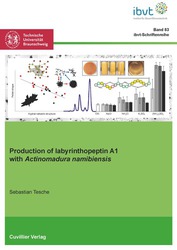| Areas | |
|---|---|
| Serie de libros (96) |
1378
|
| Nachhaltigkeit |
3
|
| Gesundheitswesen |
1
|
| Letra |
2367
|
| Ciencias Naturales |
5406
|
| Matemática | 229 |
| Informática | 319 |
| Física | 980 |
| Química | 1363 |
| Geociencias | 131 |
| Medicina humana | 243 |
| Estomatología | 10 |
| Veterinaria | 108 |
| Farmacia | 147 |
| Biología | 835 |
| Bioquímica, biología molecular, tecnología genética | 121 |
| Biofísica | 25 |
| Nutrición | 45 |
| Agricultura | 1004 |
| Silvicultura | 201 |
| Horticultura | 20 |
| Ecología y conservación de la tierra | 148 |
| Ciencias Ingeniería |
1793
|
| General |
98
|
|
Leitlinien Unfallchirurgie
5. Auflage bestellen |
|
Erweiterte Suche
Production of labyrinthopeptin A1 with Actinomadura namibiensis (Volumen 83) (Tienda española)
Sebastian Tesche (Autor)Previo
Lectura de prueba, PDF (410 KB)
Indice, PDF (89 KB)
The filamentous actinomycete Actinomadura namibiensis is the only known producer of labyrinthopeptins, a class of ribosomally synthesized and posttranslationally modified peptides (RiPPs) displaying highly attractive bioactive properties. In order to increase the labyrinthopeptin A1 productivity in shaking flask cultivations of A. namibiensis, a new cultivation method called salt-enhanced cultivation was used. Compared to the unsupplemented control, labyrinthopeptin A1 productivity was enhanced the most by addition of 50 mM (NH4)2SO4, reaching a 7-fold higher yield of 325 mg L-1 within 10 cultivation days. Salt-enhanced cultivation affected growth and product formation mechanisms, cell morphology characteristics and rheological characteristics of cultivation broth. An image analysis method was developed to quantify both the macro-morphology (pellet size and shape) and the micro-morphology (hyphal network structure) of the heterogeneous filamentous biomass in detail. Productivity-related morphological parameters were in particular the size and circularity of pellets and the degree of hyphal interweaving (hyphal network spacing). It was shown that the time-dependent change in morphology linked to the rheological properties of the cultivation broth.
The results presented in this work provide new insights into the cultivation aspects of A. namibiensis and illustrate the challenges on the way to a comprehensive understanding of the complex relationship between productivity, morphology and rheology in filamentous cultivations.
| ISBN-13 (Impresion) | 9783736973435 |
| ISBN-13 (E-Book) | 9783736963436 |
| Formato | A5 |
| Idioma | Inglés |
| Numero de paginas | 130 |
| Laminacion de la cubierta | mate |
| Edicion | 1 |
| Serie | Schriftenreihe des Institutes für Bioverfahrenstechnik der Technischen Universität Braunschweig |
| Volumen | 83 |
| Lugar de publicacion | Göttingen |
| Fecha de publicacion | 31.12.2020 |
| Clasificacion simple | Tesis doctoral |
| Area |
Biología
Microbiología y biotécnica Ingeniería mecánica y de proceso |
| Palabras claves | Actinomadura namibiensis, filamentous actinomycetes, labyrinthopeptin, lantibiotic, morphology engineering, cell morphology, image analysis, microscopy, salt-enhanced cultivation, salt supplementation, osmolality, upstream processing, medium optimization, complex medium, shaking flasks, submerged cultivation, productivity, product yield, specific growth rate, heterogeneous biomass, ammonium sulfate, mycelia, circularity, rheology, pseudoplasticity, viscoelasticity, dynamic viscosity, parallel plates, vane, space-time-yield, micro-morphology, macro-morphology, product purification, anion exchange chromatography, hydrophobic interaction chromatography, antiviral peptide, secondary metabolite, non-growth associated, filamentöse Aktinomyzeten, Labyrinthopeptin, Lantibiotikum, Morphology Engineering, Zellmorphologie, Bildanalyse, Mikroskopie, Salt-enhanced cultivation, Salz-Supplementierung, Osmolalität, Upstream Processing, Mediumoptimierung, Komplexmedium, Schüttelkolben, Submerskultur, Produktivität, Produktausbeute, spezifische Wachstumsrate, heterogene Biomasse, Ammoniumsulfat, Myzelien, Pellets, Hyphal Network Spacing, Zirkularität, Rheologie, Pseudoplastizität, Viskoelastizität, dynamische Viskosität, parallele Platten, Flügelrad, Raum-Zeit-Ausbeute, Mikro-Morphologie, Makro-Morphologie, Downstream Processing, Produkt-Aufreinigung, Anionenaustauschchromatographie, Hydrophobe Interaktionschromatographie, Adsorption, antivirales Peptid, Sekundärmetabolit, nicht wachstumsassoziiert, Wachstumsrate, Zähigkeit, Kultivierungsbedingungen, cultivation conditions, Ammoniumsalze |








